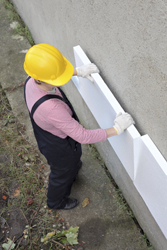Buildings optimally use the Sun's heat
Energy demands of buildings are responsible for large amounts of carbon dioxide (CO2) emissions. Exploitation of renewable solar thermal energy to reduce dependence on fossil fuels is thus the focus of intense research and development. However, techno-economical improvements are required to facilitate a match in supply and demand at a cost that is commercially attractive. EU-funded scientists focused on the development of nanotechnology-based thermal energy storage materials compatible with conventional building materials in the context of the project 'New advanced insulation phase-change materials' (NANOPCM)(opens in new window). Phase change materials (PCMs) are those that store and release latent heat in the process of melting or freezing, enabling them to provide on-demand heat or cold. They are perfect for exploiting the Sun's thermal energy, which is dependent on weather conditions and time of day. Their high energy-storage density is particularly attractive for building insulation. Scientists developed two categories of products: encapsulated PCMs using nanomaterials as additives and polyurethane (PU) foam containing PCMs together with nanomaterials. The first were produced at a pilot plant using a technique already registered under two patents. The latter were produced following standard procedures for PU foam production optimised to incorporate additives without affecting mechanical properties, curing and growth. Following existing procedures and processes enabled significant cost reductions. Original targets included a payback period of less than six years. The team outperformed its expectations with a payback period of around two years considering the cost and energy savings of the novel panels. Life-cycle assessment and toxicity studies were important pillars of the project. The team also delivered a software tool simulating thermal behaviour of products containing NANOPCM technology. This can be easily used by architects, engineers and others to determine the potential energy savings and achievable temperature in a building incorporating NANOPCM insulation materials. Smart insulation materials using nanotechnology and associated manufacturing techniques will significantly enhance thermal storage capacity of insulation systems, reducing heat losses through the walls and roofs. The EU's ambitious targets for reduced energy consumption should be easier to reach thanks to NANOPCM technology. Watch the project’s video(opens in new window) here.







